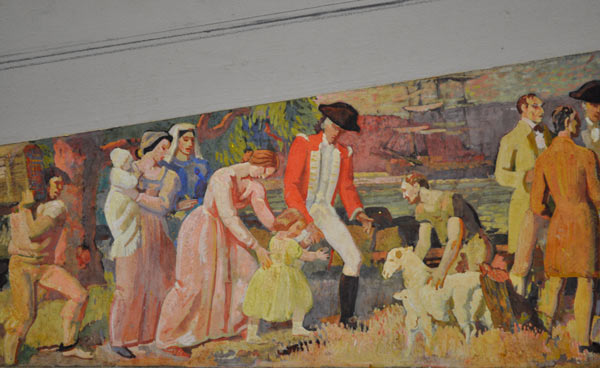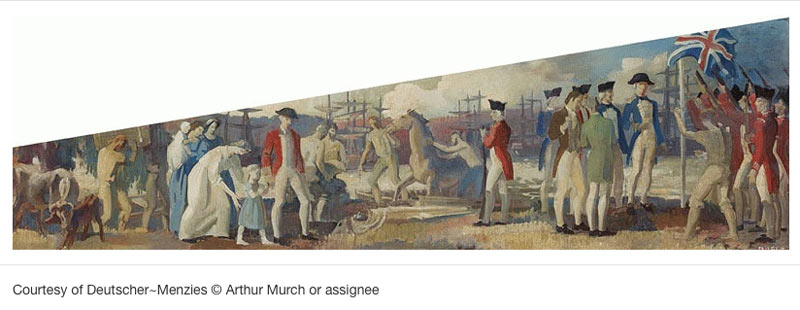Mural – The Foundation of European Settlement
Overseas Terminal, Circular Quay
In 1961 Arthur Murch was given a commission by the Maritime Services Board to paint a mural commemorating the 1788 landing of Captain Arthur Phillip and the First Fleet. The mural was the largest in Sydney at the time measuring 50 feet (15 metres) in length and is wedge-shaped. It is painted on 13 panels and is on display in the arrival hall of the Overseas Terminal at Circular Quay. A huge commission to take on, Murch was assisted by three young assistant/apprentices: David Schlunke, Helga Lanzendorfer and Julian Halls. The work required careful research to accurately reproduce historical features such as the military uniforms. Murch wrote:
The early designs for the mural explored the suitability of the chosen wall area to the subject – the flag-saluting ceremony of the 26th January 1788 at Sydney Cove. One design included convicts, the other none. The wedge-shaped area I found to be unsuited to the composition of immobile standing figures. Such a problem related to a proportion of much less length to height. It occurred to me that’s convention, used by Renaissance decorators, of including more than one episode of the same subject within the composition could be employed. I felt that a descriptive and human presentation of what the flag salute symbolised could be incorporated with the arrival of the first fleet’s personnel and the meagre nucleus of the colony’s domestic structure. I have suggested that at an appropriate location below the mural a legend should bear: 1. a quote from the diary of Hunter or Phillip; 2. a summary of numbers and status of men, women and children, animals and equipment and a descriptive map of the voyage of the First Fleet.
Ria Murch writes more on the research for the mural: p115 Arthur Murch – An Artist’s Life.
The physical challenges of creating such a large-scale work on a minimal budget were overcome by Murch – though as Schlunke says: ” it was a pretty grim tense time for Arthur and those around.” Murch built a very large wire mesh and tarpaper structure in the backyard of 109 Palmgrove Road Avalon to work on the mural. It was open on one side and had a brick floor. It looked like a very large parcel and could very well have passed as a piece of art in its own right.
So, after the final design was completed and agreed upon, the next phase of enlarging the study to finished size began.
From a painted study Murch made a monochrome photograph:

And then a high contrast scraperboard version:

David Schlunke describes the process:
I am remembering the scraperboard drawing he laboured over. It was about 4 feet long and the shape of the wall. The scraperboard was white and he painted on it with Indian ink. You can see his quite respectable calligraphic foliage of the Angophora (that he so dearly wanted to include, as well as the horse, of course). I suspect he found the top end of the mural pretty dreary, was always making sour comments about the personalities around the flag.
You can see the great deliberation that went into it. Every mark has been honed back to a kind of shorthand code for the information that was to go onto the wall. …. The scraperboard drawing was then transferred to a sheet of translucent tracing paper, photographically.
Then he ruled ½ inch square pencil lines on the translucent version. Then this was cut it into 2″ squares and made into slides.
From here he had to work at night to project each slide onto sheets of cartridge paper about 3ft square. Using 2b pencil he traced the projected image onto the cartridge paper. Then he smudged brown chalk (of his own manufacture using various ochres and a dash of plaster of Paris poured into moulds) onto the back of the paper thus making carbon paper. One of these for each 2″ slide. Then he assembled and glued the papers into manageable groups…easy enough for the low end, but quite difficult up the tall end where he had to hang the full height…how many sheets? Maybe seven? I think he hung the assembled cartoons (for that is indeed what we called the cartridge paper with chalk on the back) from the top edge of the panels, mostly only one sheet wide, but several one above the other…and traced through, lifting the cartoon to make sure it came through…Then using the “carbon paper” backing he drew his shorthand shapes through onto the priming (which was titanium white powder and linseed oil, wasn’t it?) Helga and me were not invited to help with any of this. It was a pretty grim tense time for Arthur and those around. Getting the paper squares perfectly aligned, and the “carbon” to make a clear impression must have been hell.
Then I think he worked in yellow ochre and perhaps an oxide red into the white priming. The colour was thinned with a medium of his own concoction of course, but mostly linseed oil I think. Do I recall, or do I surmise?
Isn’t it funny that he was firmly married to the “European post impressionist” colour range, yet so often began with Aussie bushwhacker ochres and red oxides!!? Indeed yellow ochre was always his favourite pigment, like onions in my cuisine.
Do you remember how he used scraps of glass for palettes? He would balance them atop his stepladder and climb up. Visitors would hold their breaths. Ever so many of these palettes cascaded to the brick floor. I witnessed at least one smashing on his bare balding head and the paint blending into his sparse hair and blood. I think Helga wanted to cry, or giggle….He would pick up the larger pieces and mosaic them on another sheet and proceed. I think there are quite a lot of tiny slivers of clear glass in the actual paint of the mural. Do you remember the visitors? So many Rubbernecks. Arthur would carry on virtually ignoring them.
Eventually Helga and me were given something unimportant to work on, only to see Arthur working over it subsequently.
And so the final finishing process went on and on. Now he was using straight artists colour…Arthur refused to go to any exhibitions during this time ” I don’t want to be influenced”. He had a reducing glass that he used quite a bit at this time to view the mural from a distance. This glass ended up in my possession. I think he gave it to me.
The mural was finally completed and unveiled in February 1963. Murch never made money on the large commissioned jobs. He wrote to the Taxation Office requesting a re-assessment of income. In his letter he said: “1961-62 income was £243, 1962-63: £1383. The Maritime Services Board withheld payment of £600 until September 1962 for work done during the previous taxation period.”
In 1988 the Overseas Terminal was reconstructed and the mural needed to be pulled down so that asbestos wall cladding could be removed. Arthur was suffering from Alzheimer’s Disease by this time. The sensitivity of the staff at the Maritime Services Board ensured proper handling of the mural.
 Murch with Mr Russell Perkins, 1987
Murch with Mr Russell Perkins, 1987

By 2000 the mural received restoration and re-assembly.
See the 7.30 Report Story here.
The Sydney Ports Authority have written more about the heritage listed mural project here.


The Foundation of European Settlement Mural
Overseas Terminal, Circular Quay
Detail from Mural



